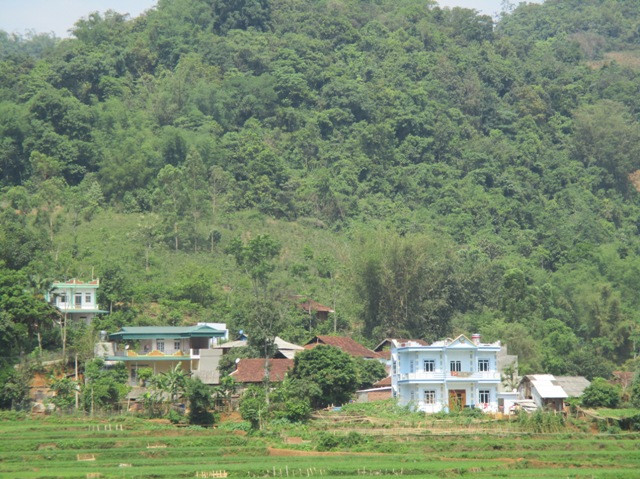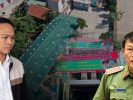A seminar on the topic „From a discussion about Hill of Dinh to the Future of Da Lat“ organized by the Đô Thị (Urban) newspaper and Save Heritage Vietnam on September 12 in the context of the public interest, especially concerned professionals, who pay attention to Da Lat mountain town when the local government held an exhibition and seek for consultation on the architectural plan of the hill area of the Governor’s Palace under the detailed planning of the Hoa Binh central area.

On June 29, leaders of the People’s Committee of Da Lat city also said that the city was in the process of building, protecting, and developing so that Da Lat would be worthy of a heritage city of landscape, architecture, and culture.
Previously, the People’s Committee of Lam Dong province announced that it had agreed on the policy of building the project of regulations on preserving landscape architecture in Da Lat, that the Lam Dong Construction Department, which was entrusted to be the investor of the project, must urgently work out outlines, tasks and cost estimates, roadmaps, and implementation plans in the coming time.
However, not long after that, the local government showed three architectural options in the Dinh hill area, generally still kept the proposal to demolish the heritage to build high buildings in the historic area of Viet Hoa Binh street of Da Lat. This means the province’s authorities ignore the proposals to preserve the Peace Area of the Ministry of Construction, the Vietnam Association of Architects, the Urban Development Planning Association as well as domestic and foreign experts.
Associate Professor, Ph.D., architect Nguyen Hanh Nguyen said the seminar attracted a large number of experts including planners, architects, lawyers, historical researchers, representatives of the organization / projects on cultural, architectural and heritage conservation. Participants hope intellectual opinions will be heard as the project is implemented.
For architect Ngo Viet Nam Son, the first person to speak up since the Da Lat planning project opened in 2014, the seminar once again rekindled the value and history of a city that was once called Indochina Capital days ago:
“Here all the people who give feedback to Da Lat love Da Lat very much. Dalat has a history of development from the late nineteenth century. Initially, it was only a French resort in Indochina, but gradually a fairly large number of Vietnamese people came to settle. In 1943, Da Lat formed a French Quarter heritage area along the two sides of Tran Phu Street (ie old Yersin Street), and Pho Viet heritage area connecting Hoa Binh area with Anh Sang hamlet.”
“In 1943, the French architect Jacques Lavisquet was very interested in embellishing these two central areas. At that time, they clearly saw two distinct identities of Da Lat, the heritage of French Street and the heritage of Pho Viet, whose center was the Hoa Binh area.
“In 2014, an important legal event was when a French architect named Thierry Huau cooperated with the Southern Planning Institute to make a master plan to adjust Da Lat.”
“I was also invited to this project advisory team and at that time I stressed that developing at a high density would ruin the landscape of Dalat. This French architect also agreed and in the plan approved by the Prime Minister, it was clear that urban development in Da Lat meant that it must be preserved but not erased. That architect was French, he emphasized the axis of French architectural heritage, and at that time I mentioned that besides the French Quarter heritage, there is Pho Viet heritage. He also agreed and put it into the so-called historic central urban area.”
“The problem is that after the Da Lat planning has been approved by the Prime Minister when doing the detailed plan for the Hoa Binh area, the investments have made suggestions, I think that the local government has not seen the danger of this plan. They find the investor’s project attractive, ie building high-rise hotels, even if the legacy is compromised, they still think this is an opportunity for Da Lay to develop new.”
“Unfortunately, the local government has not been properly consulted, we have to speak up at the national level for experts and agencies to comment on adjusting the planning plan for Hoa Binh area. Too many high buildings, too much concreting will lose the value of the climate and landscape of Dalat. I believe they have to listen.”
Associate Professor, Ph.D., architect Nguyen Hong Thuc, chairman of the Scientific Council of the Institute for Research on Settlement and Sustainable Energy, affirmed that Da Lat’s issues do not belong to the city anymore but this is a special heritage city in Vietnam. Da Lat was born at the beginning of the development of modern cities in the world, it not only put on its mark of heritage but also had international stature.
For architect Ngo Viet Nam Son, like many other places in the world, the process of planning a city to become a heritage city has always been a conflict, a tension between conservation and development.
According to him, all three architectural plans in the hill area of Governor Palace are being displayed for comments. The detailed planning of Hoa Binh Central Area, he continued, was inherently a mistake in terms of conservation and development:
“The center of Hoa Binh has a number of works bearing important marks. In short, there is Dinh hill, there is Hoa Binh area, there is a new market in Da Lat, a square, there are townhouses around the market and surrounding area along 3/2 Street, Phan Boi Chau, Minh Mang, etc… ”
“Many European cities have banned the construction of modern high buildings in the heritage zone. In Europe, people protect the interests of the people. In the investor’s proposal, they are especially interested in Dinh Hill, which is to relocate the Governor’s Palace to build a 10-story glass-covered hotel around. They cut all the old trees on the hill to do this. This is something that can be said to be very heavy on heritage because the Governor’s Palace is an important heritage building of Hoa Binh area.”
The second proposal, to demolish Hoa Binh theater to build a new modern building, and the third proposal, to build a high-rise building on the road from Xuan Huong Lake to the market, is also a violation of the landscape because it will obscure the view from the center of Hoa Binh to the lake. The plan to build a large underground car park under the square in front of the Da Lat market was also a mistake.”
“This parking lot is an unsustainable development issue, the roads of Da Lat are very small, when private vehicles are encouraged to enter, traffic congestion will increase. It looks like it only serves the hotel users, but the damage will be the people of Dalat.”
According to experts, researchers and architects in the seminar, building a 10-storey building, building a new building means concreting Da Lat, is completely destroying the landscape of Hoa Binh area. In addition, the psychology of people coming to Dalat is to find nature, mountains, flowers, not needing to find high-rise buildings like where they live.
This is also the thought of landscape planning architect Hoang Tuan Long, closely watching the seminar „From Dinh Hill Thinking About the Future of Dalat„
“Da Lat was concreted, plus the concretization of Hoa Binh area. A natural city with forests in the mountains has no more green area! It should be preserved, planted more trees, planning focused on the landscape rather than building big structures.”
“Take for example Central Park in New York. In the middle of a city with many large buildings, New York still retains an extremely large, extremely beautiful, and extremely ecological central park for people to enjoy clean and airy space. Da Lat should also create small Central Parks that are purely green, and renovate the landscape to be very beautiful.”
Instead of trying to plan the Hoa Binh area, architect Hoang Tuan Long continues to propose to preserve and embellish what Da Lat already has, boldly abandon the concreting project, save the green areas, giving back the beautiful landscape to Dalat which was a heritage of the country.
Since 2013, the People’s Committee of Lam Dong province, in cooperation with the National University of Ho Chi Minh City, organized a scientific seminar on Da Lat.
At that time, architect Nguyen Van Tat, vice president of the Vietnam Association of Architects, had an essay „Da Lat city in the forest and forest in the city: Identity Modern Urban Development Model“ with a warning in its conclusion:
“Then it is also the development that quickly overlaps that precious and generous natural picture with an opaque white of the roofs of ‘nylon technology greenhouses.’ The legitimate livelihood of the people, a key product to be developed, was put in front of an even greater benefit: the environmental protection of the sustainable tourism landscape for Da Lat. This is a big and difficult problem. Difficult does not mean there are no answers.”
According to the latest news from architect Ngo Viet Nam Son, the Da Lat government has just shown the spirit of demand by asking the Urban Development Planning Association to help organize an International Expert Conference to listen to opinions. About the adjustment of the planning for Hoa Binh, there will be a decision corresponding to the conclusion that this international conference has made.
Thoibao.de (Translated)
Source: https://www.rfa.org/vietnamese/in_depth/save-dalat-from-cimentization-09182020191850.html


























